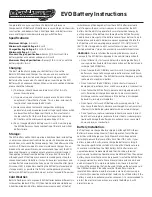
Rev. 1.10
44
November 04, 2019
Rev. 1.10
45
November 04, 2019
HT45F5Q-3
Battery Charger Flash MCU
HT45F5Q-3
Battery Charger Flash MCU
Standby Current Considerations
As the main reason for entering the SLEEP or IDLE Mode is to keep the current consumption of the
device to as low a value as possible, perhaps only in the order of several micro-amps except in the
IDLE1 and IDLE2 Mode, there are other considerations which must also be taken into account by
the circuit designer if the power consumption is to be minimised. Special attention must be made
to the I/O pins on the device. All high-impedance input pins must be connected to either a fixed
high or low level as any floating input pins could create internal oscillations and result in increased
current consumption. This also applies to the device which has different package types, as there may
be unbonded pins. These must either be setup as outputs or if setup as inputs must have pull-high
resistors connected.
Care must also be taken with the loads, which are connected to I/O pins, which are setup as outputs.
These should be placed in a condition in which minimum current is drawn or connected only to
external circuits that do not draw current, such as other CMOS inputs. Also note that additional
standby current will also be required if the LIRC oscillator has enabled.
In the IDLE1 and IDLE2 Mode the high speed oscillator is on, if the peripheral function clock
source is derived from the high speed oscillator, the additional standby current will also be perhaps
in the order of several hundred micro-amps.
Wake-up
To minimise power consumption the device can enter the SLEEP or any IDLE Mode, where the
CPU will be switched off. However, when the device is woken up again, it will take a considerable
time for the original system oscillator to restart, stabilise and allow normal operation to resume.
After the system enters the SLEEP or IDLE Mode, it can be woken up from one of various sources
listed as follows:
•
An external falling edge on Port A
•
A system interrupt
•
A WDT overflow
When the device executes the “HALT” instruction, the PDF flag will be set to 1. The PDF flag will
be cleared to 0 if the device experiences a system power-up or executes the clear Watchdog Timer
instruction. If the system is woken up by a WDT overflow, a Watchdog Timer reset will be initiated
and the TO flag will be set to 1. The TO flag is set if a WDT time-out occurs and causes a wake-up
that only resets the Program Counter and Stack Pointer, other flags remain in their original status.
Each pin on Port A can be setup using the PAWU register to permit a negative transition on the
pin to wake-up the system. When a pin wake-up occurs, the program will resume execution at the
instruction following the “HALT” instruction. If the system is woken up by an interrupt, then two
possible situations may occur. The first is where the related interrupt is disabled or the interrupt
is enabled but the stack is full, in which case the program will resume execution at the instruction
following the “HALT” instruction. In this situation, the interrupt which woke-up the device will not
be immediately serviced, but will rather be serviced later when the related interrupt is finally enabled
or when a stack level becomes free. The other situation is where the related interrupt is enabled and
the stack is not full, in which case the regular interrupt response takes place. If an interrupt request
flag is set high before entering the SLEEP or IDLE Mode, the wake-up function of the related
interrupt will be disabled.
















































